|
|
|
Sort Order |
|
|
|
Items / Page
|
|
|
|
|
|
|
| Srl | Item |
| 1 |
ID:
107960
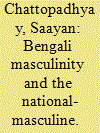

|
|
|
|
|
| Publication |
2011.
|
| Summary/Abstract |
This article examines how Bengali masculinity has been negotiated between national and ethnic/local notions of identity and suggests a new way of understanding this issue. Within the specific historiography of Bengali masculinity, concerns regarding physical strength, courage and virility of the Bengali male have been central tropes, challenged by the colonially constructed stereotype of the effeminate Bengali. The present article maps mainly nineteenth century discourses regarding Bengali masculinity and focuses on one particular strategy of three, namely, construction of a mode of mythic-historical discourse to reclaim a supposedly more masculine past for Bengali men. This suggests the notion of national-masculine as a gendered materialisation of the compensatory agency of Bengali masculinity. Shown to occur through the articulation of buddhibal in contrast with bahubal that negotiates with the hegemonic national-masculine, this throws new light on the emerging prominence of the bhadralok concept of a sophisticated Bengali gentleman.
|
|
|
|
|
|
|
|
|
|
|
|
|
|
|
|
| 2 |
ID:
107953
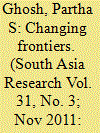

|
|
|
|
|
| Publication |
2011.
|
| Summary/Abstract |
This article focuses on patterns of the peopling of East Bengal from the seventeenth to the twentieth centuries and analyses the dynamics of this process in terms of the migrants' religious, social and political values. In this process, a number of boundaries were crossed, which South Asian Area Studies experts are still struggling to understand. Exploring this phenomenon of changing frontiers from a comparative historical perspective, the westward expansion of America during almost the same phase is analysed, showing similarities between the two phenomena, but also distinct dissimilarities. In Bengal, unlike America, there was no major violence involved and the migrations into Bengal were not at the cost of the native inhabitants, as largely happened in America. Arguing that, in grappling with the present Bangladesh-India relations, such historical knowledge is necessary, the article calls for greater interactions between intellectuals from both sides, which may be called Track III dialogue.
|
|
|
|
|
|
|
|
|
|
|
|
|
|
|
|
| 3 |
ID:
107958
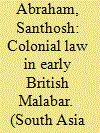

|
|
|
|
|
| Publication |
2011.
|
| Summary/Abstract |
This article examines the development of colonial law in Malabar between 1792 and 1810. Within the historical context of emerging colonialism as a pivotal factor, it shows that there was no simple unilinear process in the making of colonial law in this region of India, but rather a series of continuities and discontinuities of practices. A clear shift in the logic of governance is identified, however, as new technologies of power, particularly writing and documentation, resulted in several formalities of practices in the making of the colonial state and legal system in India.
|
|
|
|
|
|
|
|
|
|
|
|
|
|
|
|
| 4 |
ID:
107954
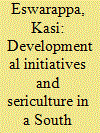

|
|
|
|
|
| Publication |
2011.
|
| Summary/Abstract |
This article demonstrates that certain developmental initiatives have been playing an important role in the socio-economic progress of rural masses in South India and typically involve a number of focused projects. Development of sericulture is shown as a key strategy for supporting backward regions. With particular reference to Kotha Indlu village of Chittoor district in Andhra Pradesh, this article explains the increased returns from sericulture as a result of development programmes. The article concludes with some suggestions to improve the long-term feasibility of sericulture.
|
|
|
|
|
|
|
|
|
|
|
|
|
|
|
|
| 5 |
ID:
107956
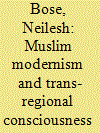

|
|
|
|
|
| Publication |
2011.
|
| Summary/Abstract |
Histories of Marxism in South Asia often focus on the great men of colonial Indian politics, such as M. N. Roy, who imagined political futures away from nation or identity, or narrowly on activists like Muzaffar Ahmad, the founder of the Communist Party of India, without consideration of the regional-historical and intellectual contexts out of which such activism and imaginations sprang. Using the Bengali Muslim context of the early twentieth century, this article examines how Muslim activists imagined their identity outside of and beyond normative frameworks such as nation or religious community. This article specifically analyses Samyabadi, a left-oriented journal published in Calcutta from 1922 to 1925, in the larger context of communist developments in Bengal and throughout India. The findings offer exciting support for new research approaches to regional and religious identity in late colonial South Asia.
|
|
|
|
|
|
|
|
|
|
|
|
|
|
|
|
| 6 |
ID:
107962
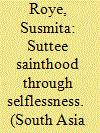

|
|
|
|
|
| Publication |
2011.
|
| Summary/Abstract |
The immolation of Hindu widows has generated much horror while remaining tenaciously mixed with clandestine admiration. Reported in many eyewitness accounts and literary works, the topic has given rise to highly contested sociocultural, legal and ideological debates, strongly linked to women's rights. But the root question has not gone away: is suttee/sati just painful female victimisation or can it also reflect powerful female agency and the power of devotion? This article examines two literary works, Maud Diver's Lilamani, in which an Englishwoman unreservedly idolises a suttee, and Krupabai Satthianadhan's Kamala, where an Indian woman expresses deep pride in sutteehood. Engaging in a search for deeper meanings, this article asks what makes these two women writers revere a suttee so totally. Can one really be a suttee-saint through selflessness, or are there some deeper meanings yet to be uncovered? A wider political interpretation is suggested to re/present the root meaning of suttee.
|
|
|
|
|
|
|
|
|
|
|
|
|
|
|
|
|
|
|
|
|